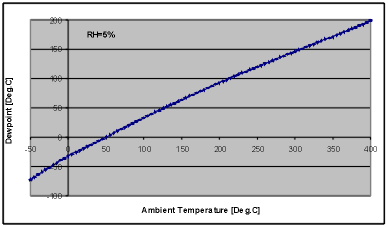Table of Content
How does it work
For the given room temperature Tin and
relative humidity RH, the
calculator solves the defining
Equation (1) for the Dewpoint
temperature Tdp.
The solution is found numerically using Newton's Method and by
initially guessing the room temperature as the dewpoint.
The algorithm must be able to evaluate the saturation vapor
pressure of water at arbitrary temperatures, and therefore relies
on interpolation formulas
for this quantity.
At freezing conditions (sub-zero Deg. C temperatures), the
Dewpoint Calculator uses the saturation
vapor pressure over ice, thus computing the frostpoint.
After finding the dewpoint temperature, the calculator determines
the heat flux q W/m2 through the window when
its inner surface is at that temperature by using the relationship
q = (Tdp - Tout) x Uw
where Tout is the outside temperature and
Uw W/m2K is the U-value of the window.
It then determines the U-value Us
W/m2K of a shutter that is consistent with that heat
flux by using the similar relationship
Us = q / (Tin - Tdp)
To design a shutter, use the actual U-value of your window,
the warmest temperature that you normally keep the room,
the coldest outdoor temperature and the most humid that the room
is likely to be.
U-values of windows
According to
Greenspec,
with the addition of Passivhaus, typical available U-values are:
| 5.0 | Single-glazing |
| 3.0 | Double-glazing |
| 2.2 | Triple-glazing |
| 1.7 | Double-glazing with low-e coating |
| 1.3 | Double-glazing with low-e coating and Argon filled |
| 0.8 | Passivhaus requirement |
| 0.4 | Triple-glazing with multiple low-e coatings and Xenon filled |
Glossary
-
Dewpoint Tdp
-
If a body is exposed to moist air and then cooled down, water will condense on its surface when the temperature drops below the dewpoint
temperature. At freezing conditions, both dewpoint (now the dew is super-cooled water) and frostpoint can coexist.
Note:
For a fixed relative humidity, neither dewpoint nor frostpoint depend on the atmospheric pressure.
However, if a moist air sample is pressurized at a constant temperature and at a constant absolute humidity, both
the relative humidity and the dewpoint will rize.
 |
| Dewpoint Versus Temperature Curve for RH=5% |
-
Frostpoint Tfp
-
Corresponding to the dewpoint for freezing conditions, the frostpoint is the temperature at which ice will form on the cool body.
The frostpoint for liquid water is slightly higher than the dewpoint. Because the formation of ice depends on a certain amount
of impurity on the surface of the body, however, you may still experience dew at subzero temperatures.
-
Boiling point
-
The temperature at which the vapor pressure equals atmospheric pressure (about 101kPa at sea-level).
Below the boiling point, the atmospheric pressure
(which equals the pressure inside the water) will prevent
evaporation inside the water body. At the boiling point, the
water body becomes physically unstable in that vapor bubbles will start to form.
-
Relative Humidity
RH
-
Degree of saturation of water in air. At a RH of 100%, the air is saturated and attains its most moist state. At a RH of 0%,
no water is present. Relative humidity is defined by Equation (1) as a function of ambient temperature T and dewpoint Tdp only,
and therefore does not depend on air pressure or altitude:
In practice, RH is often measured directly and propagated through weather reports.
-
Saturation Vapor Pressure
Pvs
-
The intensity at which water vapor will evaporate from water
(Pressure over liquid water) or from ice (Pressure over ice).
The saturation vapor pressure is a function of temperature only. It can be measured directly,
is recorded in Steam Tables, and can be evaluated with the help of interpolation formulas.
-
Chilled Sensor Hygrometer
-
Technique to directly measure the dewpoint by chilling on object (e.g. a mirror) to
the point of condensation. Sensors of this type are quite accurate, but are expensive to operate and
have a low response rate.
-
Capacitive RH Hygrometer
-
Type of sensor most commonly used to measure atmospheric humidity. These type of sensors have a typical accuracy of about
2% to 5% at RH between 10% and 90%. For very low or very high humidity, accuracy can be lower.
-
Temperature Scale
-
The Dewpoint Calculator uses the traditional temperature scales
Deg.C = Deg.K - 273.15 and
Deg.F = 9/5 Deg.C + 32.
-
Interpolation Formulas
-
There are a great deal of interpolation formulas for the saturation vapor pressure
Pvs(T).
These formulas are of varying accuracy
and have different ranges of validity. The Dewpoint Calculator uses the formula put forward in 1997 by IAPWS, the
International Association for the Properties of Water and Steam. It is very accurate for 273.15 K < T < 647.096 K,
with the relative accuracy never exceeding 0.06%. For details, please consult the source code.
-
Newton's Method
-
To solve an equation of the form
f(x)=y for x, Newton's Method computes the iterates xn
starting at a suitable initial guess x0. If the problem is not ill-conditioned, iterates
will converge quickly to the solution x.
Acknowledgments
This calculator is based on the
Dewpoint Calculator
by Wolfgang Kühn, which does all
the hard work.
It was amended for shutter calculations by Dave Howorth
- scc at howorth dot org dot uk
To Build-It-Solar Home Page...
